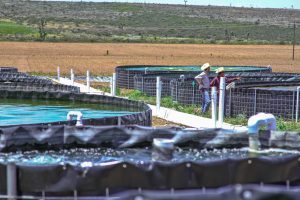The National Aquaculture and Fisheries Commission (Conapesca) pointed out that these actions help to promote productive activity in priority communities, through the repopulation of young; families are involved in the production of self-consumption and commercialization of fish, crustaceans, and mollusks.
The infrastructure has been served for two years: in 2019, a production of six million 513 thousand 82 organisms was achieved, and, at the end of 2020, the figure rose to seven million 414 thousand 830 offspring.

The Ministry of Agriculture and Rural Development, through the National Commission of Fisheries and Aquaculture (Conapesca), recovered and reactivated 11 aquaculture centers in priority communities of 10 federal entities – abandoned in previous administrations -, with the repopulation of hatchlings for production of self-consumption and commercialization of fish, crustaceans, and mollusks.
This infrastructure began to be attended to two years ago: in 2019, a production of six million 513 thousand 82 organisms was achieved and, by 2020, the figure rose to seven million 414 thousand 830 offspring, reported the head of Conapesca, Raúl Elenes Angulo.
He stressed that the agency is in charge of the 11 aquaculture centers located in Pabellón de Hidalgo, Aguascalientes; La Bombilla, Chihuahua; La Rosa, Coahuila; Jala, Colima; El Zarco, State of Mexico; Zacapu, Michoacán; Zacatepec, Morelos; Temascal, Oaxaca; Apulco, Puebla, and Chametla and El Varejonal, Sinaloa.

In aquaculture centers, those of small-scale aquaculture, self-consumption aquaculture or family aquaculture have the facility of having quality offspring at affordable prices, he stressed.
He assured that the Government of Mexico practically absorbs 80 percent of the costs of the rescued aquaculture centers since through Conapesca it is carried out in operating expenses.
He specified that this type of infrastructure is important and a priority because in the regions where it is located, it has a social and economic impact by facilitating local self-consumption of quality fish food, with protein value, in addition to being part of commercial production improvement programs in reservoirs of dams and lagoons through repopulation.
The 11 centers currently work with a supply that meets the needs and requirements made by producers and fishermen of dams, dams or those engaged in small-scale aquaculture, with satisfactory results, added Elenes Angulo.

He explained that with the National Commission of Arid Zones (Conaza) and the National Advisory Technical Council of Animal Health (Conasa), an advisory body of the National Service of Agrifood Health, Safety, and Quality (Senasica), they carry out a tilapia breeding project in five places in the country, where bodies of water and dams that have conditions for the reproduction of this species have been identified, mainly, with the support of technical assistance.

He indicated that this is a progressive program that, in its first phase, promotes self-consumption, with access to quality food and protein produced by fish, whose surpluses can be commercialized; young people and women are involved in the activity so that they see aquaculture as a productive option different from agriculture.
He pointed out that in the last two years the Bienpesca program was expanded so that from supporting coastal and offshore fishermen, it is now also supporting freshwater aquaculture producers or reservoirs of dams, as well as workers from aquaculture farms.
Source: mazatlaninteractivo.com.mx





